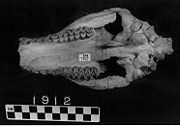
Eporeodon
Encyclopedia
Eporeodon is an extinct genus
of oreodont
belonging to the subfamily Eporeodontidae during the Oligocene
epoch (33.3—20.6 mya) existing for approximately .
 The species of the genus
The species of the genus
are among the largest members of the family
Merycoidontidae. About the size of a cow, its fossils are some of the largest found in the Badlands
. It was much larger than Merycoidodon
and Miniochoerus
, its contemporaries in the Late Oligocene. On the other hand, Eporeodon was a rare oreodont, as its fossils only make up about one percent of all oreodont fossils found in the Badlands.
, but were longer than those of Miniochoerus
.
A single specimen was examined by M. Mendoza for body mass and estimated to have a weight of 118.3 kg (260.8 lbs).

Genus
In biology, a genus is a low-level taxonomic rank used in the biological classification of living and fossil organisms, which is an example of definition by genus and differentia...
of oreodont
Oreodont
Oreodons, sometimes called prehistoric "ruminating hogs," were a family of cud-chewing plant-eater with a short face and tusk-like canine teeth...
belonging to the subfamily Eporeodontidae during the Oligocene
Oligocene
The Oligocene is a geologic epoch of the Paleogene Period and extends from about 34 million to 23 million years before the present . As with other older geologic periods, the rock beds that define the period are well identified but the exact dates of the start and end of the period are slightly...
epoch (33.3—20.6 mya) existing for approximately .

Genus
In biology, a genus is a low-level taxonomic rank used in the biological classification of living and fossil organisms, which is an example of definition by genus and differentia...
are among the largest members of the family
Family (biology)
In biological classification, family is* a taxonomic rank. Other well-known ranks are life, domain, kingdom, phylum, class, order, genus, and species, with family fitting between order and genus. As for the other well-known ranks, there is the option of an immediately lower rank, indicated by the...
Merycoidontidae. About the size of a cow, its fossils are some of the largest found in the Badlands
Badlands National Park
Badlands National Park, in southwest South Dakota, United States preserves of sharply eroded buttes, pinnacles, and spires blended with the largest protected mixed grass prairie in the United States....
. It was much larger than Merycoidodon
Merycoidodon
Merycoidodon is an extinct genus of terrestrial herbivore of the family Merycoidodontidae, subfamily Merycoidodontinae ,...
and Miniochoerus
Miniochoerus
Miniochoerus is a small extinct genus of oreodont endemic to North America during the Late Eocene which existed for approximately .-Taxonomy:...
, its contemporaries in the Late Oligocene. On the other hand, Eporeodon was a rare oreodont, as its fossils only make up about one percent of all oreodont fossils found in the Badlands.
Taxonomy
Eporeodon was named by Marsh (1875). It was synonymized subjectively with Eucrotaphus by Cope (1884). It was assigned to Merycoidodontidae by Marsh (1875), Scott (1890), Thorpe (1921), Thorpe (1937), Stevens and Stevens (1996) and Lander (1998). It's synonymized with Hypselochoerus and Pseudodesmatochoerus.Morphology
Eporeodon was a tremendous oreodont, growing to be about cow sized. Their skulls were much shorter and squatter than those of MerycoidodonMerycoidodon
Merycoidodon is an extinct genus of terrestrial herbivore of the family Merycoidodontidae, subfamily Merycoidodontinae ,...
, but were longer than those of Miniochoerus
Miniochoerus
Miniochoerus is a small extinct genus of oreodont endemic to North America during the Late Eocene which existed for approximately .-Taxonomy:...
.
A single specimen was examined by M. Mendoza for body mass and estimated to have a weight of 118.3 kg (260.8 lbs).
Species
E. occidentalis (syn. E. davisi, E. leptacanthus, E. longifrons, E. perbullatus, Eucrotaphus pacificus), E. pygmyus.

